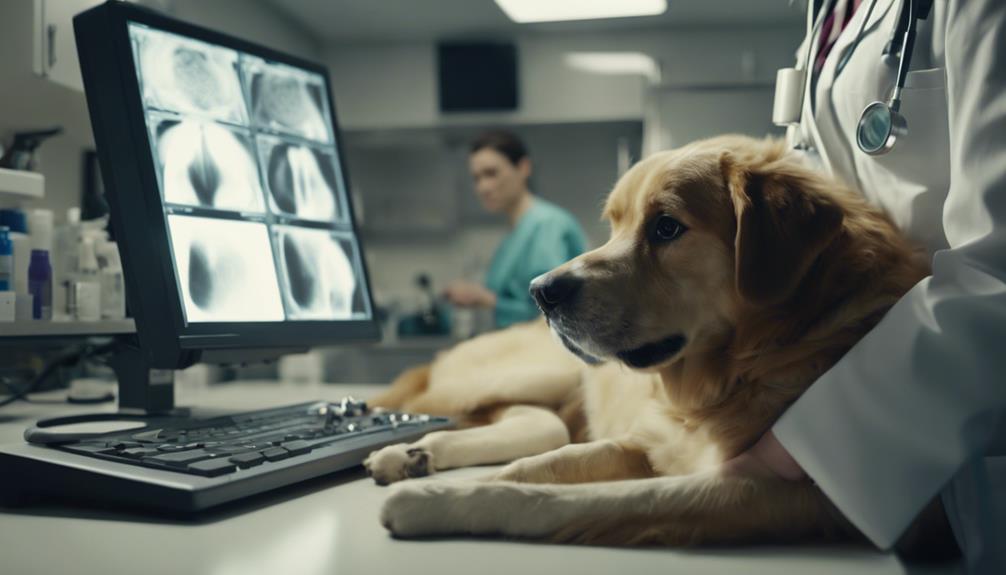In the realm of veterinary medicine, the identification and management of dog kidney stones are crucial aspects of canine healthcare. Understanding the subtle cues that may indicate the presence of this condition is vital for pet owners keen on safeguarding their furry friends' well-being.
From changes in urination patterns to potential weight fluctuations, recognizing these signs can be the first step towards timely intervention. Stay tuned to uncover the nuanced strategies and treatment approaches employed by professionals to address this common yet concerning ailment in dogs.
Key Takeaways
- Recognize signs: Increased urination, blood in urine, vomiting
- Seek veterinary care promptly for diagnosis and treatment
- Manage with prescribed medications, specialized diets, and regular monitoring
- Prevention through hydration, balanced diet, and regular check-ups
Understanding Dog Kidney Stones
Dog kidney stones, also known as renal calculi, are mineral fragments that can form within a dog's kidneys due to various factors such as metabolic imbalances, infections, and genetic predispositions. These stones can range in size and cause discomfort and health issues for the affected dog.
Female dogs are more prone to developing kidney stones, and certain breeds, like Lhasa Apsos and Yorkshire Terriers, are more vulnerable. It is crucial to differentiate kidney stones from bladder stones, which form in the bladder.
Signs of kidney stones in dogs include increased urination with little output, vomiting, weight loss, anorexia, and depression. Monitoring for these symptoms and seeking prompt veterinary care are essential for proper diagnosis and treatment.
Causes and Risk Factors
When considering the development of kidney stones in dogs, various factors come into play, influencing their formation and the risks associated with them. Some common causes and risk factors for dog kidney stones include:
| Causes | Risk Factors |
|---|---|
| Metabolic imbalances | Breed predisposition |
| Infections | Age |
| Genetics | Diet |
Metabolic imbalances, infections, and genetic predispositions can contribute to the formation of kidney stones in dogs. Additionally, certain breeds may be more prone to developing these stones, and factors like age and diet can also increase the risk. Understanding these causes and risk factors is crucial in managing and preventing kidney stones in our canine companions.
Signs and Symptoms

Symptoms of kidney stones in dogs often manifest through various observable signs that indicate potential urinary tract issues. These signs may include increased urination with little output, vomiting, weight loss, anorexia, and depression.
Blood in the urine, pain or difficulty urinating, and recurring urinary tract infections are also common indicators of kidney stones. Smaller dog breeds such as Lhasa Apsos and Yorkshire Terriers are more vulnerable to developing these stones.
Recognizing these symptoms early on can help in prompt diagnosis and treatment, preventing further complications. It is vital for pet owners to be vigilant about any changes in their dog's urinary habits and behavior to address potential kidney stone issues promptly.
Gender and Breed Predisposition
Female dogs, along with certain small breeds such as Lhasa Apsos and Yorkshire Terriers, exhibit a higher predisposition to developing kidney stones. This increased susceptibility can be attributed to various factors, including hormonal influences and genetic predispositions.
When considering gender and breed predisposition for kidney stones in dogs, it is essential to take into account the following points:
- Hormonal fluctuations in female dogs may contribute to the formation of kidney stones.
- Certain small breeds, like Lhasa Apsos and Yorkshire Terriers, have a genetic predisposition to developing kidney stones.
- Dietary factors and metabolism can also play a role in stone formation in specific breeds.
- Regular veterinary check-ups and monitoring are crucial for at-risk female dogs and predisposed small breeds.
Differentiation From Bladder Stones

In understanding kidney stone formation in dogs, it is crucial to distinguish between kidney stones and bladder stones due to their distinct locations within the urinary system. Kidney stones develop in the kidneys, while bladder stones form in the bladder. Differentiating between the two is essential for accurate diagnosis and treatment.
Kidney stones often lead to symptoms like increased urination with little output, vomiting, and blood in the urine, while bladder stones can cause similar signs but are specifically located in the bladder. Understanding the location of the stones is vital as it influences the diagnostic approach and treatment strategies.
Proper identification of whether the stones are in the kidneys or bladder is key to providing effective care for dogs with urinary stones.
Diagnosis Methods
Utilizing a combination of diagnostic techniques such as X-rays, ultrasounds, blood tests, and urine samples is crucial in accurately identifying and assessing the presence of kidney stones in dogs. These methods provide valuable insights into the size, location, and composition of the stones, guiding appropriate treatment strategies.
Key points to consider in the diagnosis of dog kidney stones include:
- X-rays: Helpful in visualizing the presence and location of stones.
- Ultrasounds: Aid in further evaluating the kidneys and detecting smaller stones.
- Blood tests: Can indicate abnormalities related to kidney function and potential complications.
- Urine samples: Essential for analyzing the urine composition and identifying any crystals or substances indicative of stone formation.
X-rays and Ultrasounds

When diagnosing dog kidney stones, X-rays and ultrasounds play a crucial role in visualizing the presence and characteristics of the stones within the kidneys. X-rays are effective in identifying the size, shape, and location of kidney stones, providing valuable information for treatment planning. They can also help differentiate between kidney stones and bladder stones.
Ultrasounds, on the other hand, use sound waves to create images of the kidneys, aiding in the detection of smaller stones that may not be visible on X-rays. Additionally, ultrasounds can assess the overall health of the kidneys and identify any related complications.
Blood and Urine Tests
To further investigate and assess the presence of dog kidney stones and related complications, blood and urine tests are essential diagnostic tools employed by veterinarians. These tests provide valuable information about the dog's overall health and the presence of any abnormalities that may indicate the presence of kidney stones.
- Blood tests can reveal elevated levels of certain substances that may indicate kidney stone formation.
- Urine tests can help identify the presence of blood, crystals, or other substances that suggest the presence of kidney stones.
- Analysis of urine pH levels can provide insights into the type of stones present.
- Monitoring urine concentration and volume can aid in evaluating kidney function and the effectiveness of treatment.
Surgical Intervention

Surgical intervention plays a crucial role in managing dog kidney stones that cause pain or significant damage to the kidneys. When kidney stones are too large to pass naturally or are causing severe symptoms, surgery becomes necessary.
The most common surgical procedures for dog kidney stones include extracorporeal shock wave lithotripsy (ESWL), percutaneous nephrolithotomy, and open surgery. ESWL uses shock waves to break the stones into smaller pieces that can be passed in the urine. Percutaneous nephrolithotomy involves making a small incision to remove the stones directly from the kidney. Open surgery is reserved for complex cases where other methods are not feasible.
Surgical intervention aims to alleviate pain, prevent kidney damage, and improve the overall health of the affected dog.
Medication and Special Diets
For dogs with kidney stones, implementing specific medication and tailored diets is essential for effective management of the condition. These interventions can help dissolve the stones, alleviate symptoms, and prevent recurrence.
Here are some key points to consider:
- Prescribed Medication:
- Veterinarian-prescribed medications like antibiotics or pain relievers may be needed to address underlying causes or manage symptoms.
- Specialized Diets:
- Special diets low in certain minerals like calcium or phosphorus can help dissolve stones and prevent their formation.
- Hydration:
- Adequate hydration through increased water intake or prescription hydration solutions can help flush out the stones.
- Regular Monitoring:
- Regular check-ups and monitoring by a veterinarian are crucial to adjust treatment plans as needed and prevent complications.
Treatment for Recurring Stones

Efficient management of recurring kidney stones in dogs necessitates a comprehensive approach that focuses on long-term prevention strategies.
To prevent the formation of new stones, ensuring proper hydration is crucial as it helps in diluting urine and reducing the risk of mineral accumulation. Additionally, feeding a balanced diet low in protein, phosphorus, and oxalate can aid in stone prevention.
Regular veterinary check-ups are essential to monitor the dog's kidney health and catch any potential issues early on. Furthermore, implementing lifestyle changes such as increasing exercise and maintaining a healthy weight can contribute to overall kidney health.
Specific Struvite Stone Treatment
To address the specific treatment of struvite stones in dogs, a targeted approach involving diagnostic assessments and tailored interventions is essential. Struvite stones are a common type of kidney stone in dogs, requiring specific management strategies to effectively dissolve and prevent recurrence.
When dealing with struvite stones, the following approaches are typically considered:
- Prescription diets low in magnesium and phosphorus to dissolve stones.
- Antibiotics to treat underlying urinary tract infections contributing to stone formation.
- Increased water consumption to help flush out the stones.
- Regular monitoring through urine tests and imaging to track the effectiveness of treatment and prevent future stone development.
Management Options

One effective approach to managing dog kidney stones involves a comprehensive evaluation of dietary modifications and medical interventions tailored to the specific needs of the pet.
Dietary changes may include reducing protein, phosphorus, and calcium intake, as well as increasing water consumption to promote urine dilution. Specialized therapeutic diets designed to dissolve certain types of stones, such as struvite stones, can be beneficial.
Medical interventions may include the use of medications to control underlying conditions contributing to stone formation or to help dissolve the stones. In cases where the stones are large or causing significant discomfort, surgical procedures may be necessary.
It is essential to work closely with a veterinarian to determine the most appropriate management plan for your dog's kidney stones.
Continuous Monitoring
Continuous monitoring of dog kidney stones is crucial to track the progression of the condition and adjust treatment plans as necessary to ensure the best possible outcomes for the pet's health. Continuous monitoring involves regular evaluations and tests to assess the status of the kidney stones and the overall health of the dog. This process allows veterinarians to make informed decisions about the most effective treatment options and to intervene promptly if needed.
Key aspects of continuous monitoring include:
- Regular check-ups with the veterinarian
- Periodic imaging tests such as X-rays or ultrasounds
- Monitoring changes in the pet's behavior or symptoms
- Adjusting diet and medication as recommended
Related Pet Health Information

Within the realm of pet health, a plethora of valuable resources exist to aid in understanding and managing various health concerns affecting our beloved animal companions. These resources cover a wide array of topics, ranging from common ailments like bladder stones and kidney disease to more specific issues such as the importance of calcium supplements for cats and the risks associated with conditions like leptospirosis and Lyme disease in dogs. By accessing these resources, pet owners can deepen their knowledge and better care for their furry friends. For a comprehensive overview, refer to the table below:
| Pet Health Topics | Description | Resource Links |
|---|---|---|
| Bladder Stones | Formation, symptoms, treatment | [Link](#) |
| Kidney Disease | Causes, signs, management | [Link](#) |
| Calcium Supplements for Cats | Benefits, dosage, recommendations | [Link](#) |
| Leptospirosis | Transmission, prevention, treatment | [Link](#) |
| Lyme Disease in Dogs | Symptoms, diagnosis, prevention | [Link](#) |
Conclusion
In conclusion, recognizing the signs of kidney stones in dogs is crucial for prompt diagnosis and treatment. Understanding the causes, risk factors, and specific treatment options can help pet owners safeguard their canine companions' well-being.
By implementing continuous monitoring and tailored management plans, veterinarians strive to alleviate the discomfort associated with this condition. Stay vigilant and seek veterinary care if you suspect your dog may be suffering from kidney stones.




